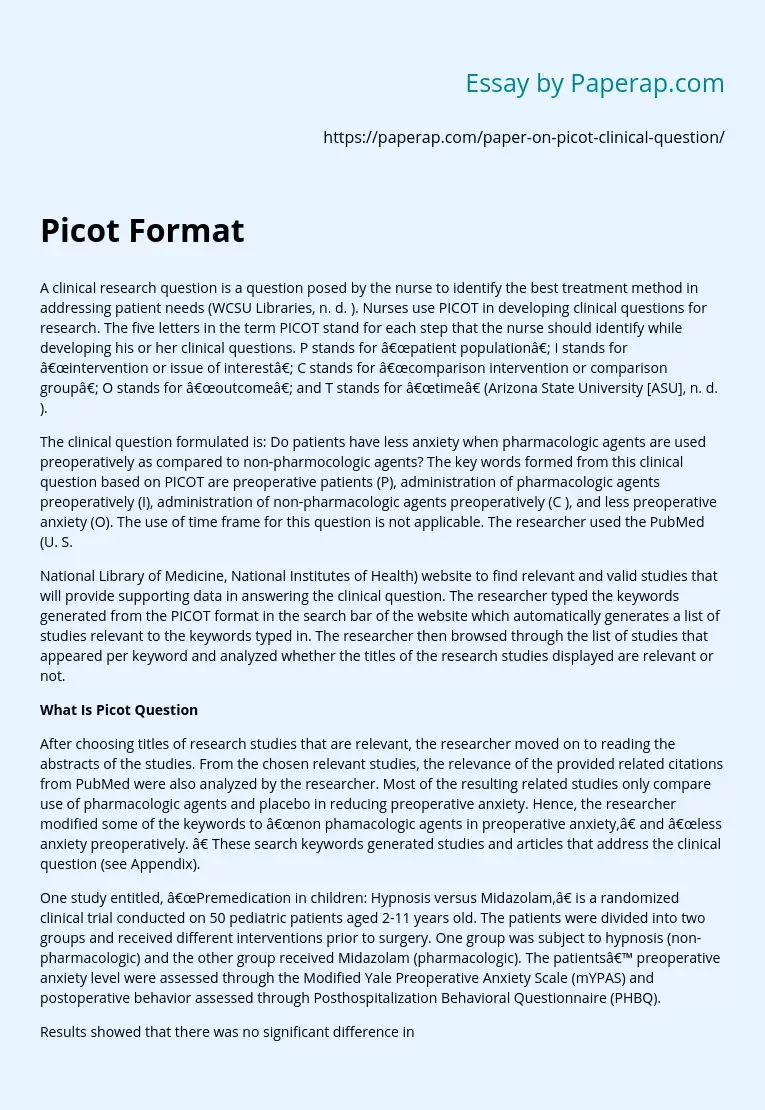PICOT Clinical Format in Nursing
A clinical research question is a question posed by the nurse to identify the best treatment method in addressing patient needs (WCSU Libraries, n. d. ). Nurses use PICOT in developing clinical questions for research. The five letters in the term PICOT stand for each step that the nurse should identify while developing his or her clinical questions. P stands for “patient population”; I stands for “intervention or issue of interest”; C stands for “comparison intervention or comparison group”; O stands for “outcome”; and T stands for “time” (Arizona State University [ASU], n.
d. ).
The clinical question formulated is: Do patients have less anxiety when pharmacologic agents are used preoperatively as compared to non-pharmocologic agents? The key words formed from this clinical question based on PICOT are preoperative patients (P), administration of pharmacologic agents preoperatively (I), administration of non-pharmacologic agents preoperatively (C ), and less preoperative anxiety (O). The use of time frame for this question is not applicable. The researcher used the PubMed (U.
S.
National Library of Medicine, National Institutes of Health) website to find relevant and valid studies that will provide supporting data in answering the clinical question. The researcher typed the keywords generated from the PICOT format in the search bar of the website which automatically generates a list of studies relevant to the keywords typed in. The researcher then browsed through the list of studies that appeared per keyword and analyzed whether the titles of the research studies displayed are relevant or not.
What Is Picot Question
After choosing titles of research studies that are relevant, the researcher moved on to reading the abstracts of the studies.
From the chosen relevant studies, the relevance of the provided related citations from PubMed were also analyzed by the researcher. Most of the resulting related studies only compare use of pharmacologic agents and placebo in reducing preoperative anxiety. Hence, the researcher modified some of the keywords to “non phamacologic agents in preoperative anxiety,” and “less anxiety preoperatively. ” These search keywords generated studies and articles that address the clinical question (see Appendix).
One study entitled, “Premedication in children: Hypnosis versus Midazolam,” is a randomized clinical trial conducted on 50 pediatric patients aged 2-11 years old. The patients were divided into two groups and received different interventions prior to surgery. One group was subject to hypnosis (non-pharmacologic) and the other group received Midazolam (pharmacologic). The patients’ preoperative anxiety level were assessed through the Modified Yale Preoperative Anxiety Scale (mYPAS) and postoperative behavior assessed through Posthospitalization Behavioral Questionnaire (PHBQ).
Results showed that there was no significant difference in the mYAPS and PHBQ scores. However, it was shown that the number of children who were anxious preoperatively in the group that received hypnosis. The study concluded that hypnosis serves as an effective intervention to reduce preoperative anxiety in pediatric patients (Calipel, Lucas-Polomeni, Wodey, & Ecoffey, 2005). In evaluating the study, both accuracy and generalizability of results serve as criteria for research validity.
A valid study exercises reliability, internal validity, measurement validity, and external validity (Gliner & Morgan, 2009). The overall validity of the study is supported by the credentials of the authors who are all medical doctors and its quantitative study design. The external validity of the study is affected by the number of samples or population used, in this case, a small sample size of 50. The internal validity of the study is affected by the equivalence of population groups, in this case, two similar groups of pediatric patients aged 2-11 years old.
The study has a small sample size which is its weak point. However, it utilized equivalent population groups (two groups with similar characteristics) of pediatric patients which is the study’s strong point for validity (Gliner & Morgan, 2009).
References
- Arizona State University. (n. d. ). PICO(T) form. Retrieved May 12, 2010, from http://nursingandhealth. asu. edu/evidence-based-practice/pico. htm
- Calipel, S. , Lucas-Polomeni, M. M. , Wodey, E. , & Ecoffey, C. (2005). Premedication in children: Hypnosis versus midazolam. Pediatric Anaesthesia, 15(4), 275-281. Retrieved from http://www. ncbi. nlm. nih. gov/pubmed/15787917.
- Gliner, J. A. , & Morgan, G. A. (2009). Research methods in applied settings: An integrated approach to design and analysis. New Jersey: Lawrence Erlbaum Associates. Retrieved from http://books. google. com/books? id=NuHHvAbTkf8C&printsec=frontcover#v=onepage&q&f=false
- WCSU Libraries. (n. d. ) Introducing… PICOT. Retrieved May 12, 2010, from http://library. wcsu. edu/web/assistance/research/nursing/tutorial/c_picot/? x=41&y=51
PICOT Clinical Format in Nursing. (2019, Dec 05). Retrieved from https://paperap.com/paper-on-picot-clinical-question/

